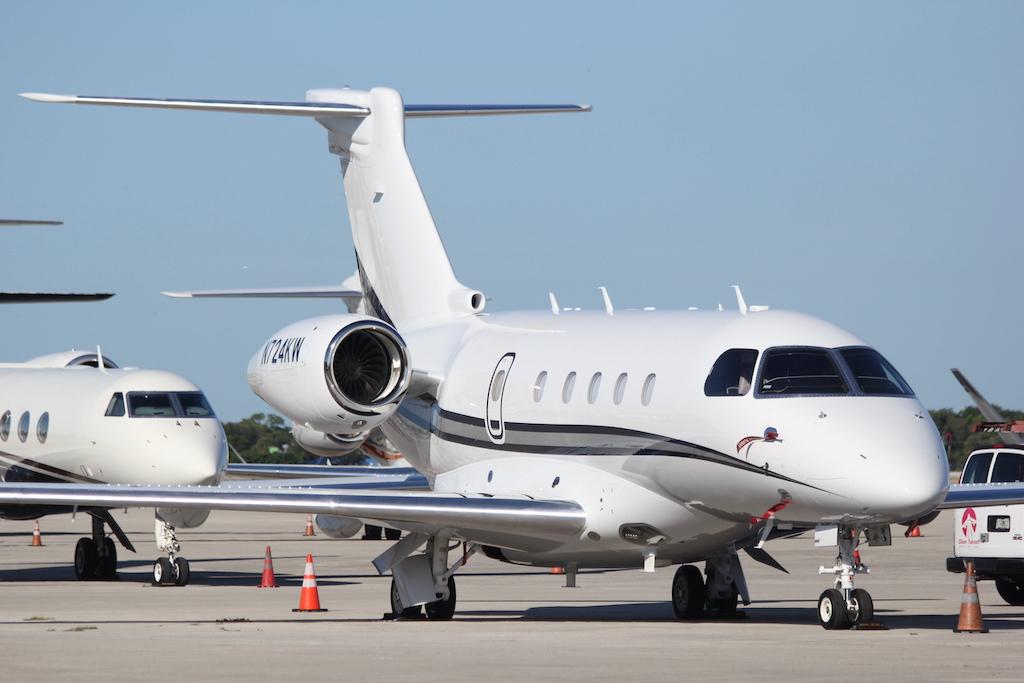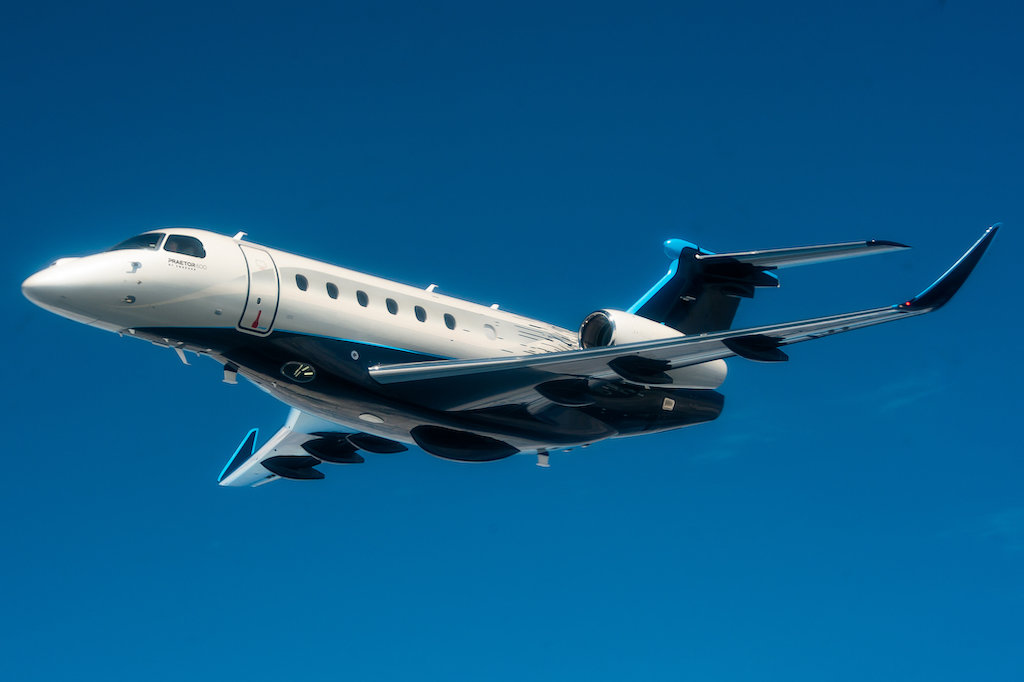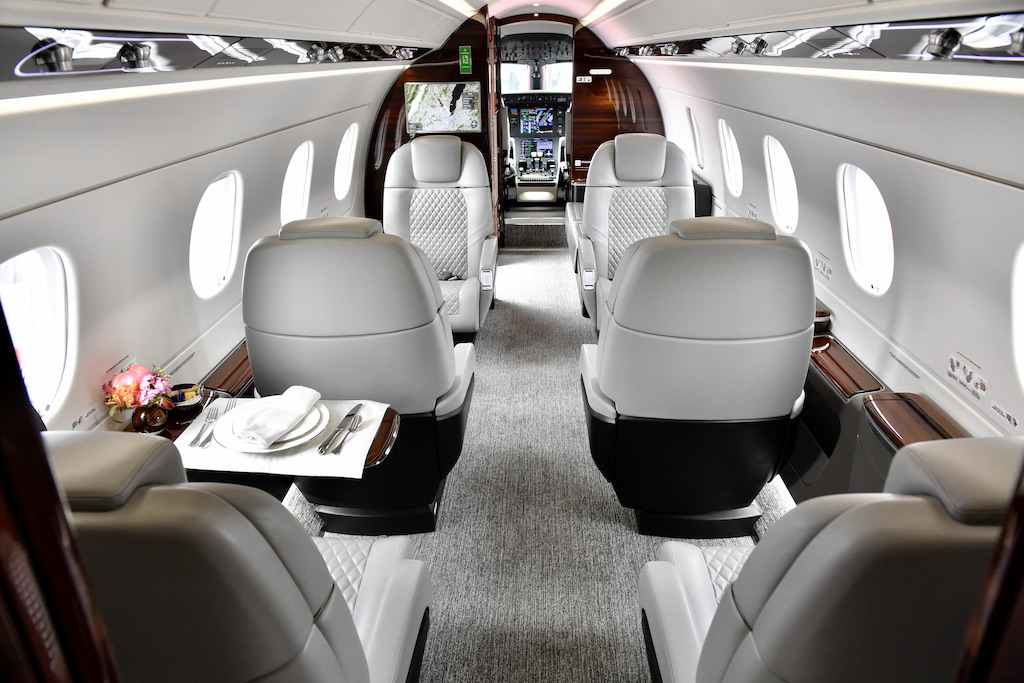
The Praetor 500 flies to a range of 3,340 nm with four passengers and two crew.
NetJets’ recent fleet agreement with Embraer for up to 250 Praetor 500s will help promote the midsize twinjet and its super-midsize sibling when they become more available in the pre-owned market, where few were listed for sale this spring, says a broker with Embraer experience.
“There may be a dual effect,” surmised Eric Hammer, Elliott Jets executive sales director. “First off, [the agreement] raises the interest level, raises the profile and awareness of the airplane, and that’s true with both the Praetor 500 and 600. It also really solidifies the model as it’s placed in the industry as a strong midsize competitor to the others that are out there.”
The agreement also “gets more bodies in the seats of the airplanes,” he said, noting that some of NetJets’ fractional customers may eventually decide to buy their own aircraft. “It increases the exposure to the buying public,” Hammer explained. “I think that’s incredibly positive for the airplane as it’s placed in the market and for Embraer as well.”
Embraer unveiled the Praetor 500 and 600 midsize and super-midsize business jets, respectively, in October 2018 at the NBAA BACE conference in Orlando. They are derivatives of earlier Embraers—the Praetor 500 is based on the Legacy 450 (EMB-545 type); the Praetor 600 on the Legacy 500 (EMB-550 type)—with new winglets, increased fuel capacity and more powerful Honeywell HTF 7500E turbofans for improved performance and range.
Midsize With Long Range

Seating up to nine passengers, the Praetor 500 flies to a range of 3,340 nm at 417 ktas average speed with four passengers, two crew and NBAA IFR reserves; it requires 4,222 ft. of runway to take off in standard day, sea level conditions at maximum takeoff weight (37,567 lb.), according to BCA’s Purchase Planning Handbook.
Nearly four feet longer at 68.1 ft., the Praetor 600 seats up to 12 passengers and flies to 4,018 nm at 423 ktas average speed with four passengers and two crew; it requires 4,717 ft. of runway on a standard day at MTOW (42,857 lb.).
Praetors have fly-by-wire (FBW) flight controls for full flight envelope protection and pilots’ side-stick controllers—features their Legacy predecessors pioneered in the midsize category. They have the Collins Pro Line Fusion flight deck with four 15-in. customizable displays and synthetic vision system. In 2020, Embraer received Brazilian ANAC and FAA certification of its synthetic vision guidance system on Praetors that allows for autopilot-flown ILS approaches to 150 ft. above touchdown during conditions of reduced visibility. An enhanced vision system and Collins HGS-3500 head-up display are options.
“The biggest draw is the fly-by-wire nature of the airplane,” Hammer said. “It’s the only one that is fly-by-wire in that size category. [The FBW system] improves the handling characteristics, it has a tremendous amount of redundancy and certainly if you talk to an Embraer sales guy it has 10 other attributes that make it better as well.”
Equipped And Average Retail Values

The BCA Equipped Price of a Praetor 500—the average price of 10 of the last 12 commercial deliveries, as available—was $18,995,000, according to the Purchase Planning Handbook. The equipped price of a Praetor 600 was $21,995,000.
The average retail price of a pre-owned Praetor 500 this spring was $17.9 million, according to the Aircraft Bluebook. Praetor 600s were selling for $21.5 million. The average retail value is the retail market price for an average (mid-time) used aircraft at the end of the previous quarter.
As of May, there were 70 Praetor 500s and 72 Praetor 600s in service with operators, according to the Aviation Week Fleet Discovery Database. Most were based in North America, with 24 Praetor 600s based in western Europe.
Hammer said he combines Legacy 450/500 and Praetor 500/600 models when considering the pre-owned market for the Embraer types. He noted that many Legacy 450s have been converted to the Praetor 500 standard by service bulletin. (Of 70 operating Praetor 500s, 30 are Legacy-to-Praetor conversions, according to Aviation Week’s database.) However, EMB-550 airframes built as Legacy 500s cannot be similarly upgraded to Praetor 600s because of changes made to a number of systems in the newer model.
The average retail price of a 2019 Legacy 450 was $17 million; a 2020 Legacy 500 was selling for $21 million, according to the Bluebook.
As of May, there were three Legacy 450s and four Legacy 500s listed for sale and no Praetors, said Hammer, referring to AMSTAT data. That represented less than 3% of the combined in-service fleet.
The Fleet Agreement

The Praetor 600 competes for buyers against the Bombardier Challenger 300, 350 and 3500, the Gulfstream G280, the Dassault Falcon 2000 and the Cessna Citation Longitude, Hammer said. The Praetor 500 mainly competes against Textron Aviation’s Citation Latitude.
Announced on May 11, NetJets’ fleet order with Embraer for up to 250 Praetor 500s beginning in 2025 could impact follow-on orders for the $19.8 million Latitude, industry experts say. NetJets started taking delivery of Citation Latitudes in 2015; since then NetJets and NetJets Europe have taken delivery of 184 Latitudes, a number representing 54% of all Latitude deliveries, said financial services company Jefferies in a note to investors. Textron Aviation “had been expecting a follow-on order to extend the Latitude campaign, but it appears that NetJets has chosen to order Praetor 500s instead,” Jefferies analysts wrote.
Speaking with The Weekly of Business Aviation, Patrick Gallagher, NetJets president of sales, marketing and service, said the fractional ownership and jet-card provider expects to continue being a customer for the Citation Latitude as well as the Longitude. “Adding the Praetor 500 allows us to better meet our overall growth plans,” he said.
Textron Aviation unveiled a new model—the Cessna Citation Ascend midsize twinjet—at the EBACE conference in Geneva in late May. Priced at $16.7 million, the 2,100 nm-range jet will replace the Citation XLS Gen 2 and is positioned more to compete with Embraer’s Phenom 300E.
Stand-up Cabin

Praetor 500/600s have 6 ft.-high, 6.8 ft.-wide, flat-floor cabins. The 500’s main seating area is 24 ft. long; the 600’s is 27.5 ft. Total baggage capacity is 150 cu. ft. for the 500 and 155 cu. ft. for the 600.
Typical seating configuration for the Praetor 500 is four seats in club configuration forward with two forward-facing seats behind; the Praetor 600 has four-place club seating forward with a side-facing three-place divan and two club seats aft. The seats recline and swivel and can be converted into fully flat beds. Both jets feature a “feels like” cabin altitude of 5,800 ft. at their cruise ceilings of 45,000 ft. and standard HEPA filters that remove bacteria from the air.
A Honeywell Ovation Select cabin management system provides 1080P high-definition video streaming and audio in Praetor cabins. Embraer equips the jets for Viasat Ka-band satellite connectivity and Gogo Avance L5 air-to-ground communications.
Embraer’s customer support network includes 70 owned and authorized service centers and a field-service fleet that delivers parts and maintenance “wherever you are,” the manufacturer says. In March, German business jet center General Atomics AeroTec Systems announced that it had received European Union Aviation Safety Agency approval to service Praetor 500/600s at its facility in Oberpfaffenhofen, Germany.
BCAʼs October 2022 Operations Planning Guide estimates Praetor 500 and 600 direct costs of $6,097 and $6,255, respectively, for a 1,000-nm mission, based on a nationwide average Jet-A fuel cost of $6.94 per gallon at the time of publication. Direct costs include mission fuel consumed, maintenance labor, parts and reserve costs apportioned to the actual flight time for the mission length.
BCA welcomes comment and insight from aircraft dealers and brokers for its monthly 20/Twenty pre-owned aircraft market feature. The focus aircraft for June 2023 is the Piaggo Avanti and for July 2023 the Piper M600. To participate, contact [email protected].




